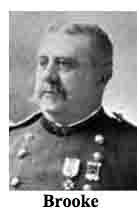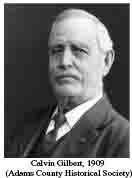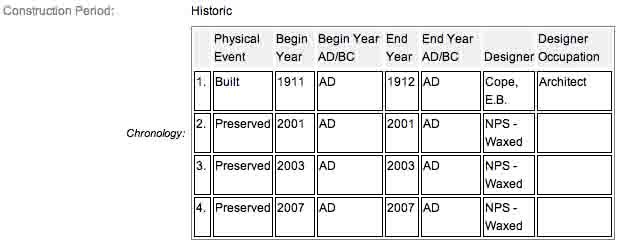
The 2nd Corps, 1st Division, 4th Brigade was also known as Brooke’s Brigade. During the battle of Gettysburg, it served as a member of Caldwell’s Division in the Second Corps, Army of the Potomac. The brigade was commanded by John Rutter (or Ruller) Brooke (July 21, 1838 – September 5, 1926), a major general in the United States Army during both the American Civil War and the Spanish American War. He served as a military Governor of Puerto Rico and Governor of Cuba. On the second day of the Battle of Gettysburg, July 2, 1863, Brooke found himself in the thick of the action when Confederatelieutenant general James Longstreet launched his assault against the Union lines south of Gettysburg. Rushed into action as reinforcements by Maj. Gen. Winfield Hancock, Colonel Brooke launched a limited counterattack against oncoming Confederate forces with his brigade in the Wheatfield. Although he was knocked out of action with a severe wound, his men temporarily stopped the Confederates and stabilized the Union line long enough to prevent a breakthrough. He retired July 21, 1902, in Philadelphia, where he lived until his death at age 88 in 1926. He is buried at Arlington National Cemetery.
The Brooke's Brigade tablet is located on the right or east side of Brooke/Cross/De Trobraind Avenue if traveling north along the road. This area is called Rose Woods. The  53rd Pennsylvania Infantry Monument is directly across the road (diagonally) from this tablet and the
53rd Pennsylvania Infantry Monument is directly across the road (diagonally) from this tablet and the  Semmes' Brigade Advance Position Marker is just a few feet away.
Semmes' Brigade Advance Position Marker is just a few feet away.  Parking is available up here at large shoulder areas on the side of the road. Take care to not park on anything remotely green looking as Park Police will happily ticket you. I visited this site on Monday, July 1, 2013 on the 150th anniversary of the Battle of Gettysburg after 5 PM, EDT. As always, I used my trusty and oft abused Canon PowerShot 14.1 Megapixel, SX210 IS digital camera for the photos.
Parking is available up here at large shoulder areas on the side of the road. Take care to not park on anything remotely green looking as Park Police will happily ticket you. I visited this site on Monday, July 1, 2013 on the 150th anniversary of the Battle of Gettysburg after 5 PM, EDT. As always, I used my trusty and oft abused Canon PowerShot 14.1 Megapixel, SX210 IS digital camera for the photos.
The monument was completed under the direction of the Gettysburg National Park Commission (established by the United States Department of War), after they took over the administration of the park from the Gettysburg Battlefield Memorial Association (whose funds had expired) on March 3, 1893, and whose stewardship was then transferred to the National Park Service in 1933) SOURCE. According to the NRHP narrative, this monument was built in 1911 but finished in 1912. I can't resolve if the 1912 date represents a completion of the physical construction of the tablet or collectively all 75 tablets. Another source wrote the last of the Confederate Brigade tablets were completed in December 1910. One would think the Union tablets would have been completed before the C.S. tablets.
These battery tablets were cast by Calvin Gilbert. Gilbert joined the 87th PA Volunteers when the "Rebellion" broke out. Since he was musically inclined, he was made a member of the regimental band. In early 1863, he was promoted to the rank of Captain and sent to Washington D.C. for commissary duty. He served in that capacity until the war ended in 1865, and at war’s end earned the brevet rank of Major.  After returning home to Gettysburg, Major Gilbert moved his family to the town of Chambersburg, where he served as the Superintendent of Schools. He also opened an iron foundry there in 1868. When Calvin learned, nearly thirty years later, in 1894, that the Gettysburg Foundry was available, he purchased it with a business partner & moved his family back to Gettysburg. For the next twenty years, the Calvin Gilbert Foundry created ironworks that are still seen today on many historic forts and national battlefields (this tablet), from upstate N.Y. to Florida to Lookout Mountain. Gilbert lived to be 100 years old & attended the Last Reunion of the Blue and Gray for the 75th anniversary of the Battle of Gettysburg when he was 99. He was a most remarkable man and lived an amazing life.
After returning home to Gettysburg, Major Gilbert moved his family to the town of Chambersburg, where he served as the Superintendent of Schools. He also opened an iron foundry there in 1868. When Calvin learned, nearly thirty years later, in 1894, that the Gettysburg Foundry was available, he purchased it with a business partner & moved his family back to Gettysburg. For the next twenty years, the Calvin Gilbert Foundry created ironworks that are still seen today on many historic forts and national battlefields (this tablet), from upstate N.Y. to Florida to Lookout Mountain. Gilbert lived to be 100 years old & attended the Last Reunion of the Blue and Gray for the 75th anniversary of the Battle of Gettysburg when he was 99. He was a most remarkable man and lived an amazing life.
There is an excellent excerpt in the American Guide Series about Gilbert attending the 75th reunion anniversary.

Look carefully on the reverse side on a few of these tablets and his name might be there; I found a tablet or two like this. The inscription on the monument reads:
 Army of the Potomac
Army of the Potomac
Second Corps First Division
Fourth Brigade
Col. John R. Brooke
27th. Connecticut (2 Cos.)
2d. Delaware 64th. New York
53d. 145th. (7 Cos.) Pennsylvania Infantry
July 2 Arrived early in the morning took position on the line from Cemetery Hill to Round Top and was the right Brigade of Division. Between 5 and 6 p.m. went with Division to Wheatfield and advanced in reserve until the Division had forced back the Confederates to the further end when the Brigade advanced on the left of Third Brigade across a marsh to the crest of a wooded hill. The Union line along the Emmitsburg Road having soon thereafter been forced back by Brig. Gen. Semmes's, Brig. Gen. Kershaw's and Brig. Gen. Wofford's Brigades which advanced in front and on the right flank. Brig. Gen. Anderson's Brigade advancing on the left flank the Brigade retired with the Division and resumed its former place in Corps line.
July 3 Constructed entrenchments and remained in former position until the close of the battle.
Casualties. Killed 8 officers 46 men. Wounded 38 officers 246 men. Captured or missing 51 men. Total 389.
There are hundreds of non-sculpted monumentation for the various C.S. & Union units which fought at Gettysburg. There are about 10 different variations of tablets, markers and monoliths by my reckoning. Six designs represent brigade (2), division (2), corps (2), & army headquarters (2), each different in a subtle way so as to distinguish between armies. Battalion/ battery / advance position markers and regimental monuments for United States Regulars & Confederate have their own distinct design (2), bringing the total to ten designs at the battlefield. The bronze tablets (the brigade monuments) were created by Albert Russell & Sons Co. of Newburyport, Mass.. The granite bases which accompany the various tablets were created by the Van Amringe Company out of Boston, Mass. The cast iron tablets were of course manufactured by the aforementioned Calvin Gilbert. The 1910 Gettysburg Commission report lists the awarded contracts to these companies (not Gilbert) for the tablets.
 All of these tablets were designed by architect Colonel Emmor Bradley Cope (July 23, 1834 - May 28, 1927). He designed pretty much every tablet for both the Union and Confederate armies, each one distinct, with several different varieties. He is buried in
All of these tablets were designed by architect Colonel Emmor Bradley Cope (July 23, 1834 - May 28, 1927). He designed pretty much every tablet for both the Union and Confederate armies, each one distinct, with several different varieties. He is buried in  Evergreen Cemetery in Gettysburg, as well he should be as this park and most of the things seen here today were designed by him and as such, are his legacy.
Evergreen Cemetery in Gettysburg, as well he should be as this park and most of the things seen here today were designed by him and as such, are his legacy.
On October 1, 1898, the Gettysburg National Park Commission in a letter to the Secretary of War gave recommendations for continuing the task of organizing & progressing the work of the GNMP. Each November they wrote their annual report which outlined the work of the GNPC for that year. The following is an excerpt from that report relevant to this waymark. The link at the end of the ¶ will take you to the entire report. The method of marking the positions of troops on this field, as approved by the War Dept., is to place the principal tablet or monument of each command at the position occupied by the command in the main line of battle, & to mark the several important positions subsequently reached by each command in the course of the battle by subordinate and ancillary tablets, with appropriate brief inscriptions giving interesting details and occurrences & noting the day & hour as nearly as possible. SOURCE
Most of the Commission reports have been digitized and can be found HERE.
Information about these specific types of monuments:
BRIGADE HEADQUARTERS MARKERS (FOR UNION & CONFEDERATE TABLETS)
The Brigade Headquarters (& Confederate artillery battalions, equivalent to Union artillery brigades) are bronze tablets mounted at an angle on a stone pedestal & describe the movements & itinerary of each memorialized unit. Union headquarters have rounded tops and square bases. C.S. headquarters have flat tops and round bases. Union headquarters are marked with their corps or service branch symbol (like a cross, clover or crescent moon), while Confederate headquarters are simply labeled "C.S.A.". There are seventy-four brigade markers at Gettysburg honoring the Union's various brigades. (Other sources say there are seventy-five). There are sixty-four brigade markers honoring the Army of North Virginia's various brigades. The Union Brigade tablets consist of sea-green granite with a square 36” x 36” base; they weigh 3500 pounds. On each pedestal is mounted a bronze tablet w/ rounded corners weighing 300 pounds. They were built by Albert Russell & Sons Co. of Newburyport, Massachusetts and Charles Kappes. The C.S. Brigade tablets consist of red circular Maine granite bases 34 1/2 inches diameter and weighing 3,000 pounds. On each base is mounted a 300 pound bronze tablet. They were built by Van Amringe Granite Co. (pedestals), Albert Russell & Sons Co., Newburyport, Mass (tablets) and Charles Kappes (foundations).
The Brooke's Brigade Tablet is a contributing feature to the Gettysburg Nat'l Military Park H.D. which is nationally significant under NR Criteria A, B, C & D. Areas of Significance: Military, Politics/Gov't, Landscape Architecture, Conservation, Archeology-Historic. Period of Significance: 1863-1938. The monument is designated as structure no. MN473.
From the Nomination Form:
1 of 75 Civil War US Brigade Tablets in Park. Records movement & itinerary of Brooke's Brigade during Battle of Gettysburg, July 1-3, 1863.
Short Physical Description:
BBronze inscription tablet, 4”0’ x 3’8”, attached to slant face of polished sea green granite monolith. 3’0” squared base of monument tapers to a smaller dimension at the tablet. All 5’4” H.
Long Physical Description:
Located on E side of Brooke Avenue, Rose Woods.

My Sources
1.
NRHP Nomination Form
2.
Stone Sentinels
3.
Virtual Gettysburg
4.
Draw the Sword
5.
Historical Marker Database
6.
Wikipedia